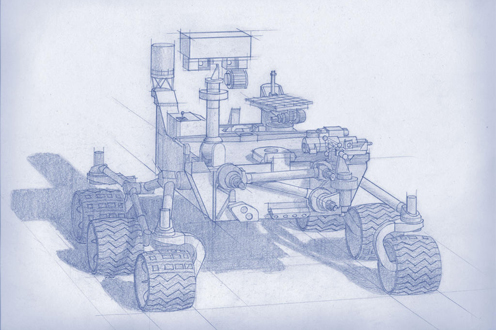In search of life on Mars
MEDA project from Spanish Astrobiology Centre (CAB, CSIC-INTA), selected for NASA's Mars2020 mission
News - 2014.7.31
MEDA, a project led by the Spanish Astrobiology Centre (CAB, CSIC-INTA) on which Doctor José Antonio Rodríguez Manfredi (Head of the CAB Instrumentation Department) will be Lead Researcher, intends to characterise the day/night and seasonal cycles in the properties of environmental dust on Mars (size and shape distribution, phase function, etc.) and the response over time to meteorological changes and phenomena. It will also record and characterise the environmental pressure on the surface, Martian air and land temperatures, relative humidity in the environment, wind speeds and ultraviolet, visible and infra-red, radiation.
MEDA will be developed by an international consortium led by the Spanish Astrobiology Centre (CAB, CSIC-INTA) that also includes the National Institute for Aerospace Technology (Spain), Universidad del País Vasco (Spain), Universidad de Alcalá (Spain), the Rocasolano Institute of Physics and Chemistry (Spain), the Jet Propulsion Laboratory (USA), NASA Goddard (USA), the John Hopkins Applied Physics Laboratory (USA), Texas A&M University (USA), Michigan University (USA), Ashima Research (USA), the University of Padua (Italy) and the Finnish Meteorological Institute (Finland). As is the case with REMS, the environmental station also designed by the CAB that is right now collecting meteorological data from Mars on the Curiosity mission, Spanish industry will play a decisive role in this new project.
The Mars2020 rover will continue in search of the objective set for its Curiosity predecessor - to explore, characterise and assess the Martian environment as a possible habitat for life. Furthermore, this new mission will explicitly search for traces and signs of Martian life from the past. Especially interesting Martian samples will also be collected so that a future mission can bring them back to Earth. Finally, it will test and validate new technology intended for use on future manned exploration missions to the red planet.
MEDA competed against 57 other proposed instruments, more than double the number usually taking part in this type of tender. The Spanish bids also included SOLID (Signs of LIfe Detector) - also led by the CAB with Doctor Víctor Parro (Head of the CAB Molecular Evolution Department) as Lead Researcher - and a magnetometer - headed by Doctor Marina Díaz from the Payloads and Instrumentation Department of the National Institute for Aerospace Technology (INTA).
About the CAB
The Spanish Astrobiology Centre (CAB) is a joint research centre of the National Institute for Aerospace Technology (INTA) and the National Scientific Research Council (CSIC). Created in 1999 and partnered with the NASA Astrobiology Institute (NAI), it is the first centre in the world to specifically focus on astrobiological research. Its objective is to study - from a transdisciplinary perspective - the origin, presence and influence of life in the universe.
The centre is home to astrophysicists, biologists, physicists, chemists, geologists, engineers, IT specialists and mathematicians, among others. Besides all aspects related to understanding the phenomenon of life as we know it (its emergence, conditions for development, adaptability or extremophilia, etc.), it also involves the search for extraterrestrial life (exobiology) and its derivations, such as space exploration (planetology) and habitability.
Over 150 researchers and technicians are currently working at the CAB on the development of various scientific projects, both at national and international levels.





